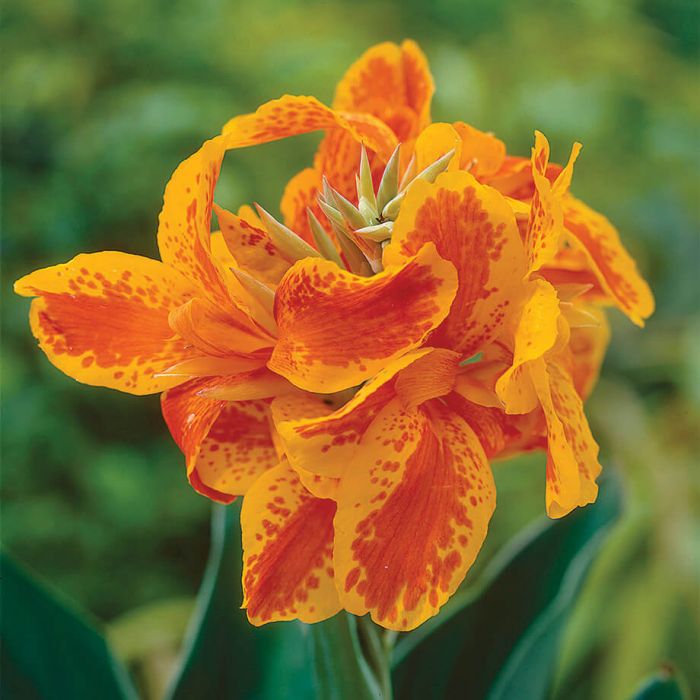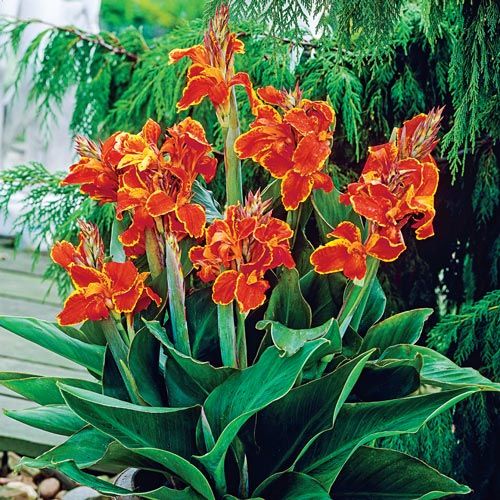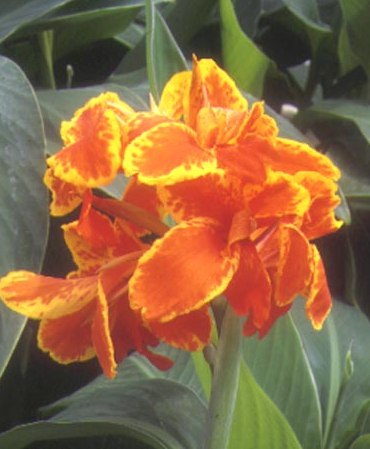Description
Taroudant Canna Lily Plants are herbaceous plants that grow pointed oval leaves on tall canes that produce gorgeous flower clusters of wide, curled blooms in bright orange with darker orange spots. Taroudant Canna Lily Plants grow to about four feet tall and their bases spread from rhizome sports which can fill a six foot diameter bed in a season. Taroudant Cannas begin to bloom in late spring or early summer and continue to produce flowers until the first frost of winter.
Not only are Taroudant Canna Lily Plants decorative, but the starchy roots, vegetative leaves, and new shoots of Taroudant Canna Lily Plants are edible. Cannas have been cultivated as food by civilizations as old as those in ancient Peru. They are recommended for growing in-ground in USDA Zones 8 to 11, and in containers in Zones 4 to 11. Taroudant Cannas do best in full sun, but can grow in partial shade as well. Add this exotic flowering edible to your garden and enjoy summer-long color and an ancient food source in your own back yard.
Taroudant Canna Lily Plant Care
Taroudant Canna Lily Plants can be planted by sowing dormant rhizomes, seeds, or established potted plants. If planting in the ground, choose a spot that gets as much full sun as possible. If you are in USDA Zone 6 or lower, plant Taroudant Canna Lily Plants in spring after all chances of frost have passed. If growing Cannas in USDA Zones 8 to 11, you can plant anytime. Plant rhizomes two to three inches deep and water once per week or more to keep the soil moist until shoots appear. Seeds can be planted in the ground or started in pots then moved into the ground when roots begin to grow at the container drainage holes.
Taroudant Canna Lily Plants benefit from three to four inches of organic mulch to keep the ground moist and to help reduce weeds and grass from establishing among the canes. Materials suitable for Canna mulching include raked leaves, grass clippings, wood chips, and pine straw. Cut back flower stalks that have gone to seed and trim off any broken canes at ground level.
Taroudant Canna Lily Plant Uses & Harvesting
Cannas (also called Canna Lilies) were a valuable food crop in both Peru and Ecuador of ancient times. Harvest the tubers of plants growing for one year or longer. The harvested, unpeeled rhizomes are baked or boiled until the interior is tender. Cooked Taroudant Canna Lily Plant roots have a starchy bland taste, much like a potato, and are typically served with butter, spices, and other aromatic vegetables in stews or as a side dish.
Taroudant Canna Lily Plant leaves are used to wrap and cook meat and rice dishes, and the new shoots can be eaten raw or cooked. Taroudant Canna Lily Plant root is also the source of arrowroot powder which is a powdered starch used for thickening. In Asia Canna root is processed into flour and used to make noodles. Canna leaves can be used to decorate tropical tables, or even as food for rabbits or goats. Taroudant Canna Lily Plant stalks and leaves are also used as mulch or can be composted with other plant materials.
Advice
Taroudant Canna Lily Plants are seldom attacked by insects or other pests, and are therefore a good specimen for growing among other crops in the edible landscape. Taroudant Canna Lily Plants can be used to create a pest-free buffer between vegetable rows, or to add color to borders around fruit trees or berry brambles.
Since Taroudant Canna Lily Plants thrive in much the same conditions as bananas and gingers, they are a good choice for growing in the same areas. One bed that contains groups of bananas, gingers, and Cannas can be watered, fertilized, and mulched as a single planting. Concentrating similar plant varieties in this way creates an efficient and productive edible garden.




What others are saying
There are no contributions yet.